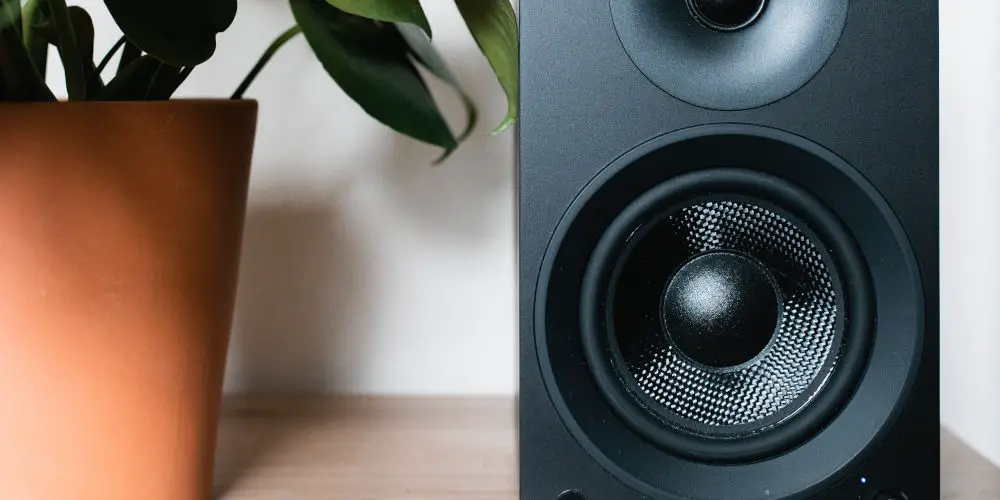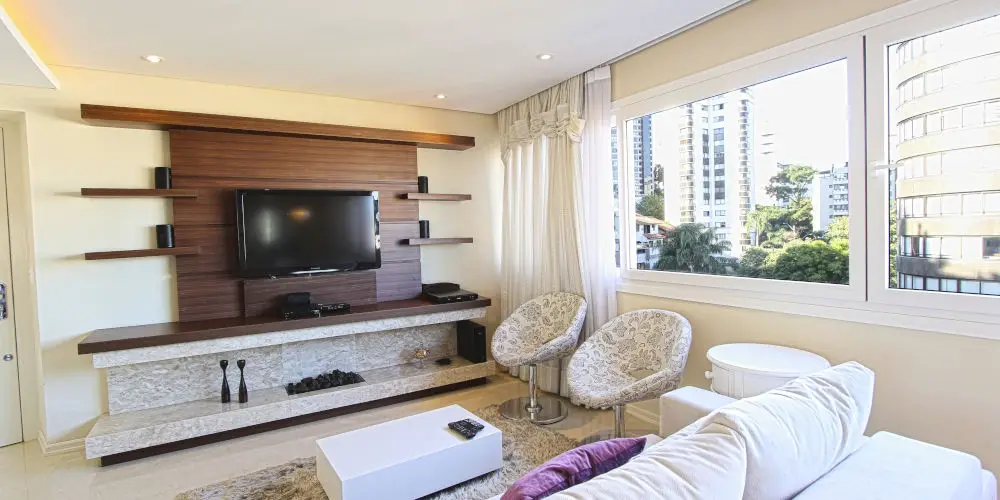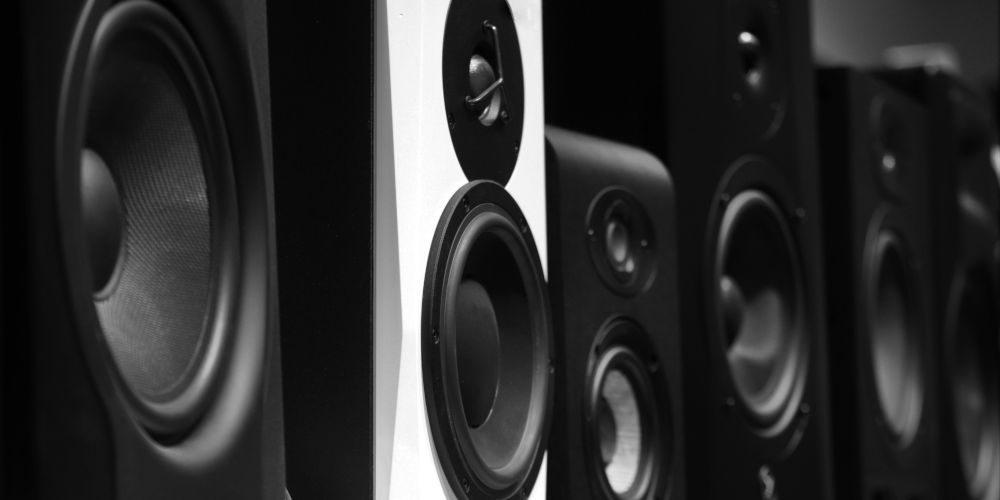How do wireless TV speakers work?

A downside of consumers demanding paper-thin units is most modern televisions have poor sound. There are several options you could use to improve your TV watching experience. The easiest solution is wireless speakers. Let’s find out how do wireless TV speakers work together!
We apparently want super thin televisions that slot into our interiors without being prominent. Any speakers on the TV shouldn’t be obvious. In many cases, they have been relocated to the rear. Manufacturers have also replaced them with smaller ones. Overall, not an ideal situation.
The result of these design choices is a muffled, thin sound that isn’t ideal for watching TV. There’s little low-end thump or high-end sizzle. Instead, you’re stuck listening to a sludge of mid-range frequencies.
Adding external speakers to your TV is hardly groundbreaking. But it’s one way to improve your TV’s sound.
You could add a soundbar, bookcase speakers or soundbar with a subwoofer, but all require additional wiring and power cables. There is one solution, wireless speakers, and they just might save the day.
Wireless TV speakers are easy to set up, can be placed around the room, and don’t require miles of cables that might limit their location.
But how do wireless TV speakers work? Let’s explore how they can improve your TV’s sound and create a better viewing experience.
How do TV speakers work?
It’s worth starting with a look at how speakers work, as it makes it easier to understand how to transmit sound wirelessly. From there, you’ll have a better idea of how the magic of wireless speakers works!
The good news is that all speakers work the same. However, wireless speakers have an additional element that makes them work without cables. They’re unbelievably clever!
A speaker converts electrical energy into mechanical energy. The audio signal is electrical energy, while the sound wave that the speaker creates is mechanical energy. You can’t listen to electrical energy! So, you need a device that converts the energy from one form to another.
We call this the driver. When the audio signals reach the driver, it creates energy that causes the driver to move a thin sheet of material on top called the diaphragm. As the driver moves, the surrounding air is pushed and pulled, creating sound waves that mimic the audio signal.
What solutions do we have?
We can easily solve a thin sounding TV with external speakers, and we’re not short of options. You could use a soundbar or soundbar with a subwoofer. There are thousands of options, including the highly affordable Groov-e Soundbar 160 (which has a built-in sub).
And while you can use a soundbar and your TV’s speakers together, it’s not a option we recommend.
You could connect your TV to an AV receiver and use it to power a pair of bookcase or tower speakers. In fact, you could use an AV receiver to power a home cinema system, complete with 5.1 surround sound speakers.
However, these options require you to run power and audio cables. You might find that you don’t have a power supply where you want to place a speaker or have a cable that’s slightly shorter than required! It’s for these reasons that wireless TV speakers make sense.
But, how do wireless TV speakers work, and can we avoid some of the problems we encounter with wired speakers? Let’s explore!
Is using wireless speakers painless?
If you don’t need audio cables between the TV and speakers, we must be using magic to transfer the sound! Or maybe not! It’s worth explaining how it works, so you can judge if wireless speakers are right for your system.
Back to electronic theory for a second. For the speaker’s driver to create sound waves that we can hear, it must receive audio signals. We can transmit audio either wired or wirelessly from our television to the speakers.
Wired speakers use cables to transmit electrical energy. The wire connects between the television and speakers. It carries the active signal from the amplifier to the speaker’s driver, which in turn converts this energy into sound waves.
Wireless speakers convert these signals into digital signals (0s and 1s). A transmitter sends this digital signal from the amp to the speaker through the air using radio waves. Hence, no need for cables.
Typically, these devices use Bluetooth or Wi-Fi protocols to transmit radio waves. On the other end, the wireless speakers use a receiver to pick up the radio waves. As this happens in real-time, there’s no noticeable delay.

What is Bluetooth technology?
You’ve probably used Bluetooth technology countless times. The most common use is to connect a phone to their car or a game controller to a console. You might have sent files between devices using it.
Bluetooth is a wireless connection standard that allows devices to share data over short distances using ultra-high frequency (UHF) radio waves. Of course, this brief explanation just scratches the surface of this complex topic, but you should now have a basic understanding of how it works.
How to connect wireless speakers to my TV using Bluetooth
Connecting wireless speakers to your TV is simple. You either need a television with built-in Bluetooth or need to purchase a Bluetooth transmitter, such as the Sennheiser BT T100.
In the next section, we’ll look at a range of TVs currently available that offer Bluetooth capabilities. But first, let’s look at how to connect a Bluetooth transmitter to your TV and wireless speakers.
Firstly, connect your Bluetooth transmitter to your TV’s audio output. Depending on your transmitter, it may need mains power, so you’ll want to plug it in. Next, pair the transmitter with your Bluetooth speakers. After pairing the devices, you can enjoy superior TV sound!
Televisions that work with Bluetooth speakers
Most smart TVs usually have built-in Bluetooth connectivity. So, pairing your TV with Bluetooth speakers is super easy and only takes a few seconds.
Samsung Smart TVs
Most modern Samsung TVs support Bluetooth connectivity.
- Open the Settings menu on your TV
- Navigate to Sound
- Select Sound Output
- Select Bluetooth Speaker List
- Set your Bluetooth device to begin actively pairing and read the user guide for your Bluetooth device
- Select the device you wish to pair to the TV
- Select Pair to connect.
LG TVs
As one of the first manufacturers to add Bluetooth functionality to their televisions, you should find your LG TV can easily connect to wireless speakers.
On your speaker:
- Press and hold the Power button on your speaker until the power button flashes twice (a tone may play to signal power has been turned on)
- Press and hold the Bluetooth button for 2-5 seconds
- When the Bluetooth icon starts flashing, your speaker is in pairing mode.
Next, on your LG TV:
- Select the Settings icon
- Select Advanced Settings
- From the Sound menu select Sound Out
- Select LG Sound Sync Bluetooth from the list, then select Detect
- Choose your device from the list to pair
- It may take 1-2 seconds for audio to play when you first turn on your TV.
Sony TVs
Available since 2017, Sony has quickly added Bluetooth connectivity to many of its TV models. If your TV has A/V sync in the TV settings menu, you can easily pair it with wireless speakers.
- Activate your speaker’s Bluetooth pairing mode
- On your Sony TV, scroll down on the Home menu to the Settings icon
- Under the Network & Accessories menu, click on Bluetooth settings icon
- Turn on the Bluetooth and set On as default
- Select the Device list to see connected devices
- If the speaker is not yet connected, click on Add Accessories. It will automatically search for available devices
- Click on your device name to complete pairing and connection.
Panasonic TVs
Connecting wireless speakers to a Panasonic TV is painless, as most modern units support Bluetooth.
- Enable pairing mode of speakers
- Press the menu button on the remote
- Select Set up
- Next select Bluetooth Set up
- In the following menu, select Devices
- Select the name of the headphones and click OK to confirm
- After successful pairing, the device list and the name of the speakers with the status “Connected” are displayed.
Apple TVs
As one of the leaders of smart TVs, Apple has changed the game. All of their TVs include Bluetooth connectivity as standard, and pairing devices is very easy.
- Put your Bluetooth speakers in pairing mode using the instructions that came with it
- On your Apple TV, go to Settings
- Select Remotes and Devices
- Next, select Bluetooth and your Apple TV will search for nearby Bluetooth devices
- Choose your Bluetooth speakers
- If asked, enter a four-digit code or PIN. On your Apple TV, your speakers should now appear in My Devices.

How far can you place a wireless speaker from a TV?
The range is one of the most common questions when considering how do wireless TV speakers work. While it depends on the device, typically the maximum distance you can place your wireless speaker from the TV is 15 metres.
Remember, the wireless range is always an estimate. It’s influenced by objects that could block the wireless signal, reducing its strength.
Do Bluetooth Speakers sound good with a TV?
They might not match the sound quality you can get from a soundbar, but Bluetooth speakers are often a superb option when choosing wireless TV speakers. They will sound far superior to your standard TV speakers. Plus, you’ll be able to position them for the best sound.
For the best results, invest in a stereo wireless speaker or a pair of speakers. Avoid buying the cheapest option, as they typically sound flat and lifeless. It’s worth spending a bit more and enjoying a better TV sound.
If you can, listen to different options before you buy speakers, as you’ll make a better decision. Regardless of the wireless TV speakers you buy, experiment with where you place the speaker and how you position it.
What are the best wireless speakers?
There are plenty of options when picking the ideal wireless speaker to use with your TV. Our favourites include the JBL Charge 5, Sony SRS-XB33, Bang & Olufsen Beoplay M3, Cambridge Audio YOYO S and Sonos Roam Portable Stereo Speaker.
All of these options are affordable yet provide a superior sound quality over cheap wireless speakers.

So, how do wireless TV speakers work?
Now you know how do wireless TV speakers work, you can improve your TV’s sound in minutes. If your TV doesn’t offer Bluetooth, you’ll need a transmitter for your wireless speaker to work.
Thankfully, if you have purchased a TV in the last 6 years, it’s likely to come with Bluetooth built-in. So, it’s a matter of activating the right settings and pairing your speaker with your TV. You should be up and running in a few minutes.




